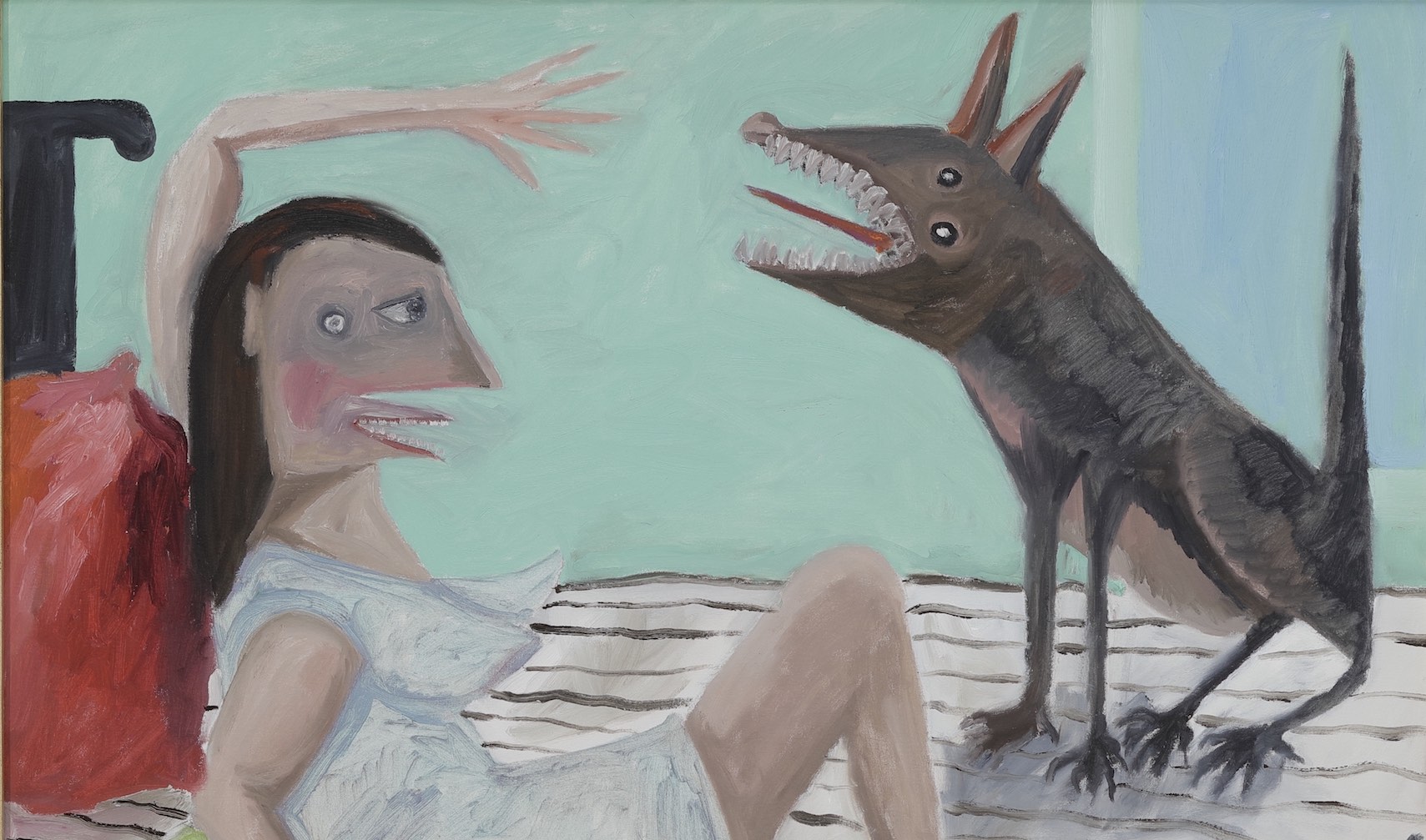
Víctor Hugo Pérez
Algo evidente pero difícil de concebir
Exhibition
-> Jun 20 2024 – Aug 17 2024
Proyectos Monclova presents the exhibition Algo evidente pero difícil de concebir by Víctor Hugo Pérez.
These look like simple paintings of female figures accompanied by animals; canvases full of color made with energetic brushstrokes. At first glance, they are uncomplicated domestic scenes, the results of a self-taught practice along the lines of art naïf. As Jean Dubuffet said about untutored paintings, in such works there is “a quality that is so precious in every human gesture: ease, abandon, relaxation.” The paintings and ceramics of Víctor Hugo Pérez (Guadalajara, Jalisco, 1975) combine these qualities highlighted by the champion of Art Brut with a tenacious, painstaking interpretation of the history of art and of the pottery traditions of his home state, something that appears certain but difficult to specify.
The U.S. painter George Condo (whose work has some connections to that of Víctor Hugo Pérez) used to say that his work had to do with the interchangeability of languages in art: “you might feel the background has the shading and tonalities [of] a Rembrandt portrait, but the subject is [...]painted like some low-culture, transgressive mutation of a comic strip.” Condo was referring to his portraits, conceived according to his theory of “psychological cubism:” an entertaining exploration of the human psyche based on avant-garde forms.
Like Condo’s portraits, these scenes by Víctor Hugo Pérez also attend to the lessons of cubism (the faces of his women cite Picasso’s with unshakeable faithfulness) and his animals unflinchingly evoke those of Rufino Tamayo. Most of his paintings take up the classic motif of a woman posing with her pet, like Manet’s Olympia: a paradigmatic work in the genre, whose caricatures of the era swapped the image of a sweet little kitten for that of a cat raising its hackles, a sexual allegory that did no favors for the painting when it was shown in 1865.
And it is precisely in this fluidity between the satirical distortion of popular cultural forms and the expressive deformation of twentieth-century art that the work of Víctor Hugo Pérez finds its place with “ease, abandon, relaxation,” as Dubuffet would say.
In tune with this are his set of ceramics and the artist’s skill as a potter, which displays an eloquent knowledge of the pottery techniques of Jalisco. His sculptures of animals and vessels decorated with paint or sgraffito are unique pieces with a double importance, first in that they embody his “land” in two senses of the word: as a place of origin and as raw material. In the second place, they are a way of understanding creation as an artisanal and artistic experience, both manual and intellectual. His works in clay partake of the same strategy as the carved frames of his paintings, in that their presence is consubstantial with his pictorial discourse. As the artist himself points out in relation to his frames, they are “extensions” of the paintings.
With his frames, Víctor Hugo Pérez also reveals his attraction to the history of art. His idea of the frame as an ornamental extension of a painting is very interesting, and since the invention of the picture in the Middle Ages, frames have been a matter of concern for painters. The sixteenth and seventeenth centuries were especially fertile in works that took the frame to be a fundamental part of a given piece, whether by painting it into the picture (generating an illusory frame) or by valuing its merger with the painted image, contained by the frame itself. In a notable study of this topic, The Self-Aware Image, Victor Stoichita describes portraits by the Flemish painter Jan Gossaert (Mabuse) in which the frame is part of the painted image, with the figure spilling out on top of it, creating the illusion of emerging from the work. Over a century later, Poussin’s canvases had to have a frame that separated them “from other neighboring objects” with a soft golden hue that would be suited “quite delicately” to the colors of his painting. In both cases, the frame played a leading role, which Víctor Hugo Pérez himself does not neglect. In his way, he seems to adapt himself to fit Mabuse’s and Poussin’s decisions about their frames. As Stoichita puts it, “whereas a painting’s effective frame functions to separate art from reality, the painted frame blurs or erases this limit.”
It is clear that the gold-leaf bestiary of Víctor Pérez Hugo’s frames (incidentally, a wink at colonial art) aims to move part of the painted scene into the real space of the spectator. These sculptural frames participate in their way “both in the world of the spectator and in that of the image,” as Stoichita indicates. In the same way, he paints scenes of the pictures on pitchers and plates, items used in homes which therefore belong to real, tangible space.
In another order of ideas, the motifs of his rustic frames evoke medieval and pre-Hispanic art, and like the rest of his work, evince a clear attraction to things primitive, recalling Gauguin’s Polynesian reliefs in wood. On this theme, Víctor Hugo Pérez wants to be seen as a "primordial being.” It is an intelligent, meaningful phrase, if we contextualize it in relation to his work. The word “primordial” has many synonyms, but there are two that describe the diaphanous form of this work: primitive and original.
The profoundness of all these aspects makes these works by Víctor Hugo Pérez very insightful, pervaded equally by an ease and a certain levity; as I wrote at the outset of this text: something obvious but difficult to conceive.
— Carlos E. Palacios